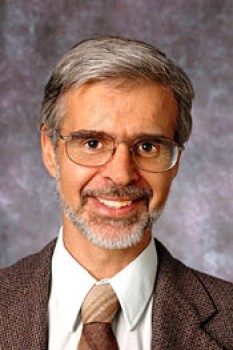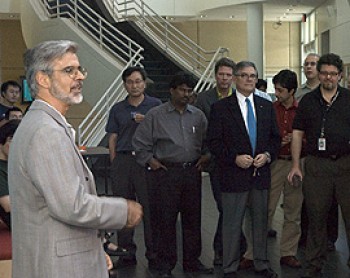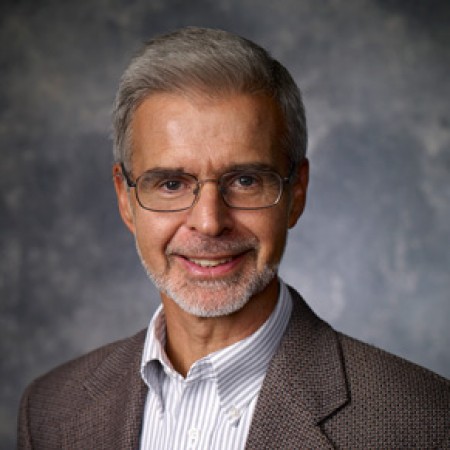Post Doc - Surface Physics
Bell Labs - 1981
Professional Preparation
Ph.D - Physics
Cornell University - 1980
Cornell University - 1980
B.A. - Physics
Princeton University - 1974
Princeton University - 1974
Research Areas
Optical spectroscopic and imaging techniques
Optical spectroscopic and imaging techniques to explore elementary processes on surfaces and at interfaces of technologically important electronic, photonic, organic and biological heterostructuresInfrared Absorption Spectroscopy
The implementation of infrared absorption spectroscopy to develop a detailed mechanistic understanding of semiconductor surface cleaning (both by wet and dry techniques), passivation and chemical functionalizationThin dielectric films in liquids, UHV, gaseous ambients
Sensitive in-situ methods to probe the interaction of chemical species and the formation of thin dielectric films in a variety of environments, including liquids, ultra-high vacuum (UHV) and gaseous ambientsOther research Interests
- Microelectronics
- Optoelectronics
- H2 storage for hydrogen fuel economy
- Organic electronics
- Nanoelectronics
- Biosensors and graphene
Microelectronics
By identifying the surface modification after various wet chemical processes (HF etching, acid/base cleaning and etching) for several types of semiconductors (groups IV, IV-IV, III-V), by characterizing the nature of H, Cl, OH and oxide passivation of semiconductor surfaces, and by uncovering the growth mechanism of high-k dielectrics on silicon and germanium. We are exploring the growth by Atomic Layer Deposition (ALD) of Al2O3, HfO2, La2O3 with sub nm equivalent oxide thickness (to replace SiO2), and of metal contacts (TaN, Cu, Ru) and investigating the best wet chemical cleaning methods for high mobility substrates (e.g., Ge, InP) to replace silicon in future CMOS devices. We are also studying elementary processes at the surface of SiC, an important substrate for high-temperature, high-speed and high-voltage electronics.Optoelectronics
By providing chemical information and badly needed fundamental understanding of III-V semiconductor surface passivation. After studying wet chemical etching and oxidation of InP, we are now exploring gaseous oxidation in controlled environments (e.g., UHV).H2 storage for hydrogen fuel economy
By examining the manner in which hydrogen molecules interact and get incorporated into complex metal hydrides and metal organic framework (MOF) materials. In the case of metal hydrides, we study the dissociation and subsequent adsorption of H2 on Ti-doped aluminum surfaces to better understand and control the formation of complex metal hydrides (e.g., NaAlH4). For the MOF materials, we focus on the weak interactions between H2 molecules and the metal and organic ligands to design more effective ways of increasing the hydrogen concentration.Organic electronics
By characterizing the chemical and structural nature of self-assembled monolayers (SAMs) on both metal and semiconductor surfaces. We are focusing on providing chemical and structural information to understand electronic conduction in organic materials by paying special attention to contact issues (substrate/SAM interfaces and effects of depositing top metal electrodes on SAM films). We are also developing spectroscopic methods to study the dependence of electronic conduction on conformational changes within the SAMsNanoelectronics
By using biological approaches to patterning surfaces on the nm and sub-nm scale. For instance, the possibility to manipulate DNA scaffolding is used to meet tight nanolithography requirements of integrated nano-circuits. An important aspect of this work is the control of DNA bonding to semiconductor surfaces. To this end, we are working on the fundamentals of DNA/surface interactions.Biosensors and graphene
By understanding the interaction of biological macro-molecules (DNA, glucose, LDL, etc.) with both organic and inorganic substrates. For instance, by studying the modulation of the electric field and charge transfer mechanisms by biological molecules, we are devising ways to implement electronic detection of biological species. We are also studying the chemistry of graphite with aim to produce high-quality graphene (via graphene oxide) and to understand the oxidation of graphene using oxygen plasma, ozone and wet chemistry.Publications
Selective adsorption of SO2 into microporous paddlewheel frameworks, K. Tan, P.
Canepa, Q. Gong, J. Liu, D. H. Johnson, A. Dyevoich, P. Thallapally, T. Thonhauser, J. Li,
and Y. J. Chabal, Journal of Functional Materials (under review) (2013). 2013 - Publication
Diffusion of small molecules in metal organic framework materials, P. Canepa, N. Nijem,
Y. J. Chabal, and T. Thonhauser, Physical Review Letters 110 (2), 026102 (2013). 2013 - Publication
Recovery of nonwetting characteristics by surface modification of gallium-based liquid
metal droplets using hydrochloric acid vapor, D. Kim, P. Thissen, G. Viner, D. W. Lee, W.
Choi, Y. J. Chabal, and J. B. Lee, ACS Applied Materials and Interfaces 5 (1), 179 (2013). 2013 - Publication
Vanadium oxide nanowire-Graphene binder free nanocomposite paper electrodes for
supercapacitors: A facile green approach, S. D. Perera, A. D. Liyanage, N. Nijem, J. P.
Ferraris, Y. J. Chabal, and K. J. Balkus Jr, Journal of Power Sources 230, 130 (2013). 2013 - Publication
A High Vacuum Fracture Facility for Molecular Interactions, K. M. Liechti, S. R. Na, M.
Wakamatsu, O. Seitz, and Y. Chabal, Experimental Mechanics 53, 231 (2013). 2013 - Publication
Oriented graphene nanoribbon yarn and sheet from aligned multi-walled carbon
nanotube sheets, J. Carretero-Gonzlez, E. Castillo-Martnez, M. Dias-Lima, M. Acik, D. M. Rogers, J. Sovich, C. S. Haines, X. Lepr, M. Kozlov, A. Zhakidov, Y. Chabal, and R. H.
Baughman, Advanced Materials 24 (42), 5695 (2012). 2012 - Publication
Effect of back-gate biasing on floating electrolytes in silicon-on-insulator-based
nanoribbon sensors, P. G. Fernandes, R. A. Chapman, O. Seitz, H. J. Stiegler, H. C. Wen, Y.
J. Chabal, and E. M. Vogel, IEEE Electron Device Letters 33 (3), 447 (2012). 2012 - Publication
Towards modelling the vibrational signatures of functionalized surfaces: carboxylic acids
on H-Si(111) surfaces, C. G. Feugmo, B. Champagne, Y. Caudano, F. Cecchet, Y. J. Chabal,
and V. Ligeois, Journal of physics. Condensed matter : an Institute of Physics journal 24
(12), 124111 (2012). 2012 - Publication
Projects
Hydrogen storage in nanoporous materials
2009–2009 Y. J. Chabal, American Physical Society, Pittsburgh, PA March 16-20, 2009. (Davisson-Germer Prize talk)In-situ studies of high-k dielectric on semiconductors and metal films on high-k dielectrics
2009–2009 Y. J. Chabal, Joint AVS and Taiwan Annual Physical Society Meeting on Beyong Si CMOS, Tapei, Taiwan, Jan. 20-21, 2009.In-situ studies of high-k dielectric on semiconductors and metal films on high-k dielectrics
2009–2018 Y. J. Chabal, 3rd International Workshop on high- dielectrics on high mobility channel materials, Tsing Hua University, Hsinchu, Taiwan, Jan. 19, 2009.Initial growth of metal films using atomic layer deposition
2008–2008 Y.J. Chabal, J. Kwon, M.Dai, S. Park, R. Gordon, 8th International Conference on Atomic Layer Deposition, Bruges, Belgium, June 29-July 2, 2008.Hydrogen storage in nanoporous materials
2009–2018 Y. J. Chabal, Physics Colloquium, University of Texas at Dallas, March 23, 2009.Additional Information
Patents
- Granted: US 6,388,290 B1:Single Crystal Silicon on Polycrystalline Silicon Integrated Circuits Yves J. Chabal and George K. Celler.
- Granted: US 6,825,538 Semiconductor device having a high K gate dielectric and method of manufacture thereof Yves J. Chabal, Martin L. Green and Glen Wilk
- Granted: US 7,223,677 Process for fabricating a semiconductor device having an insulating layer formed over a Semiconductor Substrate Yves J. Chabal, Martin Frank and Glen Wilk.
- Filed: A Method for Semiconductor Device Fabrication in which an insulating Layer is formed over a Semiconductor Substrate Yves J. Chabal, Martin Frank, Marin L. Green and Glen Wilk.
Awards
- Davisson-Germer Prize in Atomic or Surface Physics (2009)
- IBM Faculty Award (2003)
- Fellow of the American Physical Society (1996)
- Fellow of the American Vacuum Society (1995)
News Articles
Grant Aids Quest to Use Hydrogen for Clean Energy
 Researchers at UT Dallas and Rutgers University have received a $1 million grant from the U.S. Department of Energy to explore a key component in making hydrogen a widely used form of clean energy. Hydrogen could be a significant part of a clean-energy economy – powering motor vehicles in particular – but storage has been a stumbling block. Scientists are searching for a practical alternative to either compressed gas or chilled liquid hydrogen. The UT Dallas/Rutgers team is exploring a technology known as a metal organic frameworks.
Researchers at UT Dallas and Rutgers University have received a $1 million grant from the U.S. Department of Energy to explore a key component in making hydrogen a widely used form of clean energy. Hydrogen could be a significant part of a clean-energy economy – powering motor vehicles in particular – but storage has been a stumbling block. Scientists are searching for a practical alternative to either compressed gas or chilled liquid hydrogen. The UT Dallas/Rutgers team is exploring a technology known as a metal organic frameworks.
Technology Awards Salute Entrepreneur, Researcher
A technology breakthrough and an emerging company with close connections to UT Dallas have each been honored with one of the Metroplex Technology Business Council’s annual Tech Titan awards. Researcher Yves Chabal received the Tech Titan Tech Innovator award for work that promises to greatly improve semiconductor devices’ performance in health care and solar power applications. And MicroTransponder, a biotechnology firm sponsored by The Institute for Innovation and Entrepreneurship at UT Dallas, won the Tech Titan Emerging Company Award. Chabal’s work lays the groundwork for attaching virtually any organic molecule to silicon. In addition to enabling biosensors that detect minute quantities of substances such as cancer-marker proteins, the new technology promises a new generation of higher-efficiency solar cells that could incorporate sunlight-sensitive biomolecules, for example, that capture photons and transfer the energy to the electronic substrate.Prof Lauded for Groundbreaking Semiconductor Work
 The American Physical Society has awarded a UT Dallas researcher one of the society’s highest honors, recognizing Dr. Yves Chabal’s development of methods to better understand processes that take place on the silicon surface that is literally the platform for the multibillion-dollar semiconductor industry. “Yves’s development of infrared spectroscopy in the 1980s to understand the processes that occur on silicon surfaces during semiconductor manufacturing changed how everyone in the semiconductor industry does their work,” said Bruce Gnade, vice president for research at UT Dallas. “His work has had tremendous impact. In the world of infrared spectroscopy of semiconductor surfaces,Yves is the world’s expert.” Dr. Chabal is head of the Materials Science and Engineering Department in the Erik Jonsson School of Engineering and Computer Science at UT Dallas and the first holder of the school’s Texas Instruments Distinguished University Chair in Nanoelectronics.
The American Physical Society has awarded a UT Dallas researcher one of the society’s highest honors, recognizing Dr. Yves Chabal’s development of methods to better understand processes that take place on the silicon surface that is literally the platform for the multibillion-dollar semiconductor industry. “Yves’s development of infrared spectroscopy in the 1980s to understand the processes that occur on silicon surfaces during semiconductor manufacturing changed how everyone in the semiconductor industry does their work,” said Bruce Gnade, vice president for research at UT Dallas. “His work has had tremendous impact. In the world of infrared spectroscopy of semiconductor surfaces,Yves is the world’s expert.” Dr. Chabal is head of the Materials Science and Engineering Department in the Erik Jonsson School of Engineering and Computer Science at UT Dallas and the first holder of the school’s Texas Instruments Distinguished University Chair in Nanoelectronics.
Researchers Drafting Plans for Tiny Assembly Lines
A University of Texas at Dallas team will play a key role in a new $15 million research project designed to enable manufacturing at an almost unimaginably small scale: one atom at a time. “This breakthrough technology will make it possible to manufacture devices with atomic precision by exploiting our established ability to remove individual hydrogen atoms from a silicon surface using a scanning tunneling microscope,” said Robert Wallace, a professor of materials science and engineering in the Erik Jonsson School of Engineering and Computer Science at UT Dallas and a co-principal investigator in the project. Funded for $1.8 million over the next four-and-a-half years, the UT Dallas team also includes Yves Chabal, head of the Jonsson School’s new Materials Science and Engineering Department and holder of the Texas Instruments Distinguished University Chair in Nanoelectronics, and K.J. Cho, an associate professor of materials science and engineering and physics.Preeminent Scientist Yves Chabal to Join UT Dallas
Dr. Yves Chabal, one of the world’s foremost authorities on semiconductor surfaces, semiconductor materials and the interfaces between them — areas that are central to developing future generations of microchips — is joining The University of Texas at Dallas, where he will be the first holder of the Texas Instruments Distinguished University Chair in Nanoelectronics.The $2 million chair was made possible by the Texas Nanoelectronics Research Superiority Initiative, which is a joint venture between the State of Texas Emerging Technology Fund, The University of Texas System, UT Dallas, UT Austin, UT Arlington and private industry, to make Texas a leader in nanoelectronics research.
